
< home < content next: Rimma Gerlovina Cubes >
RIMMA GERLOVINA AND VALERIY GERLOVIN
TRESPASSING
(A SHORT OVERVIEW OF THE ARTWORK)
© 2010, Rimma Gerlovina and Valeriy Gerlovin
PART 1: EARLY JOINT WORK, MOSCOW
The beginning of that artistic thread traces back to Russia during those hopeful years of the seventies when, in Moscow art circles, we were called "conceptualists." We described some of the evolutionary events and vistas of that past in our early book Russian Samizdat Art, which appeared in 1986, seven years after our departure from Russia in July 1979. Samizdat art was indeed conceptual in its guise, and was something that was brewing in the isolated, virtually hermetic, vessel of Soviet Russia, whose constitution permitted almost everything de jure, but where almost everything was forbidden de facto. In the seventies, conceptual samizdat art was an attractive forbidden fruit that ripened illegally on the tree of life in the Soviet paradise. As artists we partook of that fruit, not fully aware that one day we would have to leave. In 1977 our performance Costumes, in which we were dressed in garments featuring drawn "costumes" of Adam and Eve, seemed already to predict our departure to the many-tongued land of good and bad opportunities.

| Rimma Gerlovina, Valeriy Gerlovin, performance Costumes, May 1, 1977, near Moscow. Photo by Victor Novatsky |
While living in Moscow, our works were frequently smuggled abroad. During the Eastern European Biennial in Venice in 1977 (further info), the international press picked up our performance Zoo - in which we were seated naked in a cage labeled "Homo sapiens, a group of mammals, male and female" - as a symbol of the encagement of Russian culture by the Soviet regime. As one might expect, this focal event created for us many problems with the authorities that subsequently led to our departure.
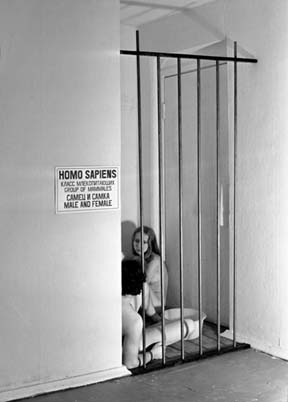
| Rimma Gerlovina, Valeriy Gerlovin, performance Zoo - Homo Sapiens, Feb.17,1977, Moscow. Photo by Victor Novatsky |
The main feature of all our works, both those made separately and in collaboration, is their deployment of a language of coded simplicity. Grasping a creative process through concepts requires an alertness that is quick and clear, similar to Albert Einstein's maxim that everything should be made as simple as possible but not simpler. The style of our artwork in general has arisen out of precisely such a configuration. Akin to mythological patterns, which transmit culturally rooted ideas, even our early works made in Russia seem to be cross-cultural at their core, exactly as providence deemed our lives to become.
A few words have to be said about our joint work, which began with our artists' books in 1972 and extended to different media: objects, performances, and photography. The series of tactile objects includes the soft encyclopedia Who is Who (1977), a linen bag filled with forty-two cushions labeled with such statements as "I am the best," "I am you," "I am Gog and Magog," "I am a minister of life," and "I am in the bag," and so on.

Rimma Gerlovina, Valeriy Gerlovin, Who Is Who: Soft encyclo-pedia, 1977, canvas bag with the embroidered title, 42 cushions with labels, 22 x 16 x 10¼". |
Another tactile object, A Horse in the Shape of a Snake (1977), filled with different scattered hidden objects that may or may not be determined by touch. Each of them has a label, such as: "neck," "Chinese smile," "my voice," "take it easy!" "It's not my end," etc.
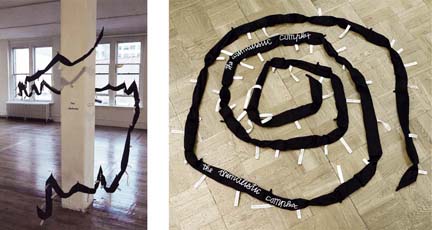
Rimma Gerlovina and Valeriy Gerlovin, Animalistic Complex,1977, fabric, small objects, length 353 x 2½". (Left) view of the exhibition Young Fluxus, Washington Project for the Arts (WPA), Wash. D.C., 1982; (right) at the exhibition Russian Lettrism, Central House of the Artists, Moscow, 2009. Photo by Andrei Babkin. |
The box-object Stones (1977) is a collection of stones with cards describing the "destiny" of each stone. For example, stone #69 is a corner stone, #72 pleasant to touch, #85 a twin of 86, #99 is a part of Sisyphus' stone, #100 a petrified eye, and stone #124 is lost without further notice.
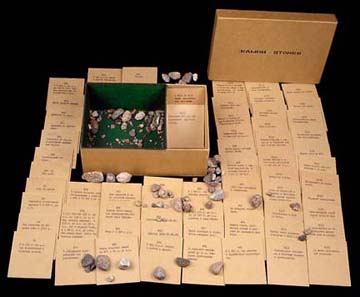
Rimma Gerlovina and Valeriy Gerlovin, Stones, 1977, 160 stones, 62 cards on Russian and English, fabric, cardboard box, 9¾ x 6½ x 3¾". Collection of the The Guggenheim Museum, New York. |
We collaborated on several albums - The Trees, or the Manual "How to Photograph Dreams" (1978) and Transformation of Functions (1978), both with photographs by Igor Makarevich - and the series of utopian projects. A Utopian Project of the All-World Birthday Celebration (1977) suggested that all people born on the same day gather in one spot of the globe when the day comes and celebrate together, thus keeping mankind united every day of the year. To utilize everyone's potential and therefore that of humanity as a whole, A Utopian Project for a Complete Exchange (1977) proposed a list of many-sided exchanges among individuals of varying nationalities, ages, viewpoints, ideals, documents, loves, pasts and futures, spiritual outlooks and body types, etc. Our experiments in the production of the art almanac Vozdukhoplavanie (Aeronautics, 1973) culminated in publishing activity in New York. Together with Vagrich Bakhchanyan we issued a series of six assemblings titled Collective Farm, whose pages are made of envelopes with inserts showing works by different artists from various countries.

(Left) Rimma Gerlovina, Valeriy Gerlovin, Heart, 1974. (Right) Rimma Gerlovina, Valeriy Gerlovin, Vagrich Bakhchanyan, Collective Farm, international assembling of bound envelops: #1 Kolkhoz, #2 Letters to the USSR, #3 Post Office Dinner, #4 Wonderkids, #5 Five Year Plan, #6 Stalin Test, 1981-1986, New York, 100 or 50 copies. |
A significant portion of our performance work is incorporated into the album Mirror Games.
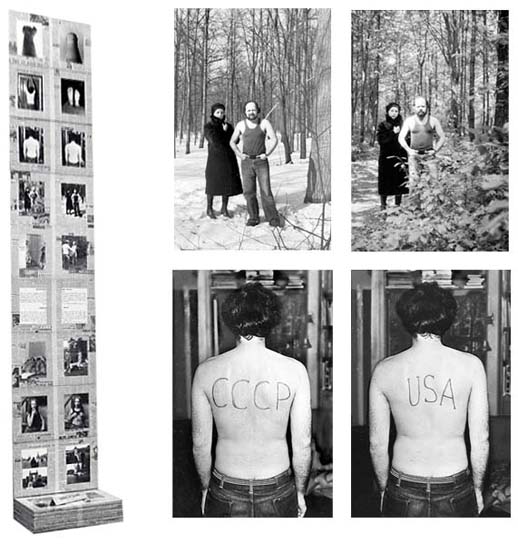
Rimma Gerlovina, Valeriy Gerlovin, Mirror Game, 1977, 30 plates, each 14 x 24". (Left) View at the exhibition Russian Samizdat Art, at The Los Angeles Contemporary Exhibitions (LACE) CA, 1984; (right) two plates with performances Winter-Summer and USSR - USA, 1977. Photographs by Victor Novatsky. Art Performance Biennial, New York, 2011 (link). |
Centre Pompidou Collection: (Cubes) (Mirror Game) (2x2=4) (Ursa Major)
Some of the pieces stand alone, as in the triptych The Eggs (1977, photo by Viktor Novatsky), which develops in three stages: the first depicts two eggs with our bodies in the embryonic position inside them, in the second we are frying the eggs, and in the third picture we are eating the eggs as a self-sacrificial meal. Supper at last. This performance was enacted in a ritornello manner, seemingly returning to the initial state, but on a higher octave. It was like an Ouroboros snake eating its own tail and thus recreating itself through its own renewed substance. For as long as man is sensitive to the metaphoric games that propose participation in the universal, it is possible to trace in them the law of regularity in nature.
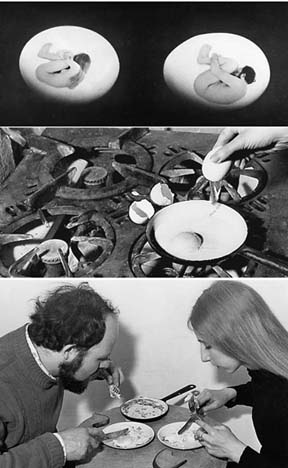
Rimma Gerlovina, Valeriy Gerlovin, performance Eggs, 1977.
Photographs by Victor Novatsky |
Now, if we step aside to view historically how it was seeded and proceed according to the rule "women first," the picture of our conceptual beginning would look as follows. Next: Rimma Gerlovina Cubes>
LINKS: